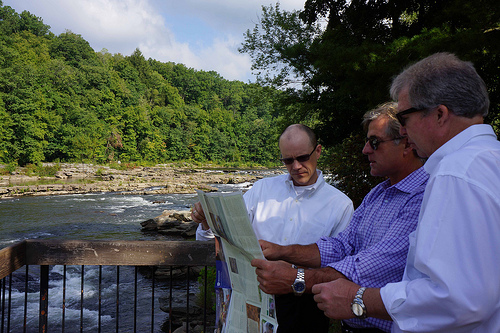
USDA Rural Development Deputy Under Secretary Doug O’Brien (left) and Rural Development State Director Thomas Williams (right) review the Great Allegheny Passage trail map with David Kahley (center) of The Progress Fund. USDA photo by Dawn Bonsell
USDA Rural Development Deputy Under Secretary Doug O’Brien recently spent a few days in Pennsylvania talking with flourishing businesses in charming trail towns along the Great Allegheny Passage (GAP), a rail trail that runs from Pittsburgh to Washington D.C. Many businesses along the trail have received funding through The Progress Fund, a non-profit community development lender. The Progress Fund is the recipient of several Rural Development Business Program loans and grants which were passed on to the trail town businesses to help spur economic development in distressed rural areas. Read more »
Growing up, all Michelle Cox could think about was being a teacher. She envisioned herself in a classroom making a lasting impact on young lives, becoming one of those teachers students would remember forever.
Today, Cox is making a significant contribution as a teacher, but her students are not in the classroom. They are her colleagues within the Food Safety and Inspection Service’s Office of Field Operations. Cox is a Supervisory Consumer Safety Inspector (SCSI), and her job involves supervising and training new meat, poultry and egg products inspectors. A SCSI also performs a variety of food inspection activities, but it is the instruction aspect that has most captured Cox’s heart.
“This is one of the most rewarding jobs I have ever had,” Cox said. Read more »

Military veterans-turned-beginning-farmers learn how to build mobile poultry units at an Armed to Farm workshop. Photo credit: University of Arkansas
For many military veterans and their families, the transition from the military to civilian life is a complex undertaking; however, reports and personal accounts indicate that many military veterans have discovered that farming offers a place for employment, training and healing. The problem is there are few educational programs tailored to meet the particular needs and abilities of returning veterans.
The National Institute of Food and Agriculture’s (NIFA) Beginning Farmer and Rancher Development Program (BFRDP) makes it possible to fill that gap in training. At the University of Arkansas, Dr. Dan Donoghue used BFRDP funds to develop internships, workshops and online courses that focus on the needs of veterans interested in pursuing farming after their service to our country. Read more »

Grass and cotton fields in the Texas High Plains study. Credit: Vivien Allen (Texas Tech University).
This post is part of the Science Tuesday feature series on the USDA blog. Check back each week as we showcase stories and news from USDA’s rich science and research profile.
Words like eco-friendly, green, fair, climate-friendly, community-based and organic are popping up daily – in the news, in ads and labels, and in conversations ranging from kitchen tables to international conferences. All of these and more come under the umbrella of sustainability, which people often describe as caring for people, planet and proceeds all at the same time. Read more »

A portion of the 1,288 solar panels on 1.5 acres, which are connected to a 250 kW inverter to produce an estimated 600,000 kW hours of alternating current each year at the Forest Service’s San Dimas Technology Development Center. (Recsolar photo)
About 25 miles east of Los Angeles, the Forest Service’s San Dimas Technology Development Center is ready to start operations using a photovoltaic array to supply the buildings there with a potential 600,000 kilowatt hours of current each year.
“This system has made the San Dimas Center a ‘net-zero energy’ facility, the first in the U.S. Department of Agriculture,” explained Forest Service Chief, Tom Tidwell. “This means the facility produces more renewable energy per year than the total energy used by the facility.” Read more »
More than 800 students, teachers, elected officials and community leaders were present at the new Dillon Middle School dedication on Thursday morning, September 6th. Several years ago, a letter was written to Congress pleading for help to replace the 100 year old dilapidated school by then-eight grader, Ty’Sheoma Bethea.
Doug McKalip, Senior Policy Advisor for Rural Affairs with the White House Domestic Policy Council stated, “I think Ms. Bethea’s letter shows that an individual can have an impact, that the Obama Administration is listening, that we monitor closely the items that folks send by letter, email, and telephone. And that there often is action from the input.”
“This state of the art school is dedicated to the academic advancement of our children. I am pleased that the promise to the children of Dillon County has been kept,” said Vernita Dore, USDA Rural Development state director. Ms. Dore was instrumental in helping to fund construction of Dillon County Middle School, which replaces the old and dilapidated JV Martin Junior High, which was mentioned in President Obama’s first State of the Union address. Read more »




